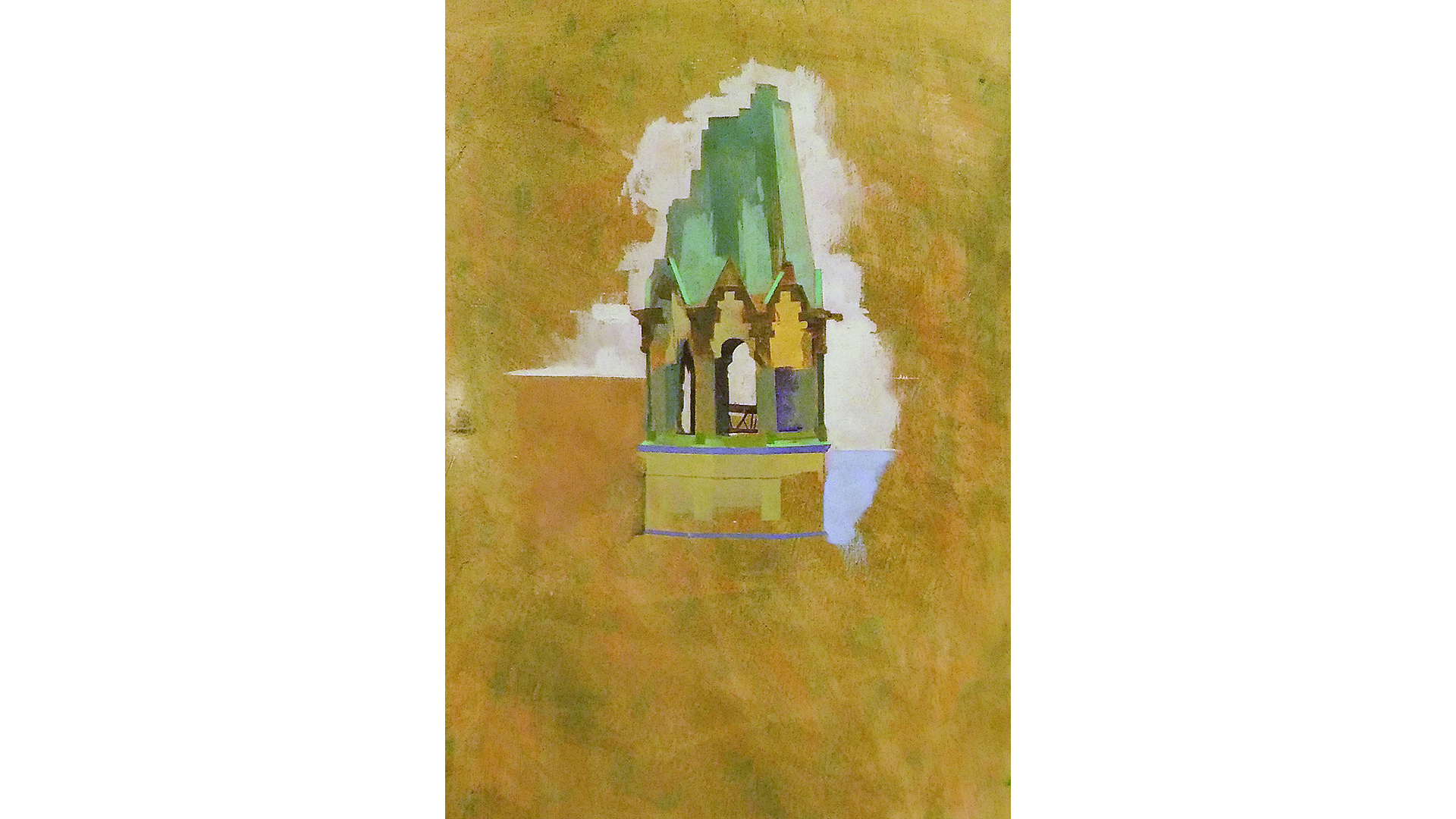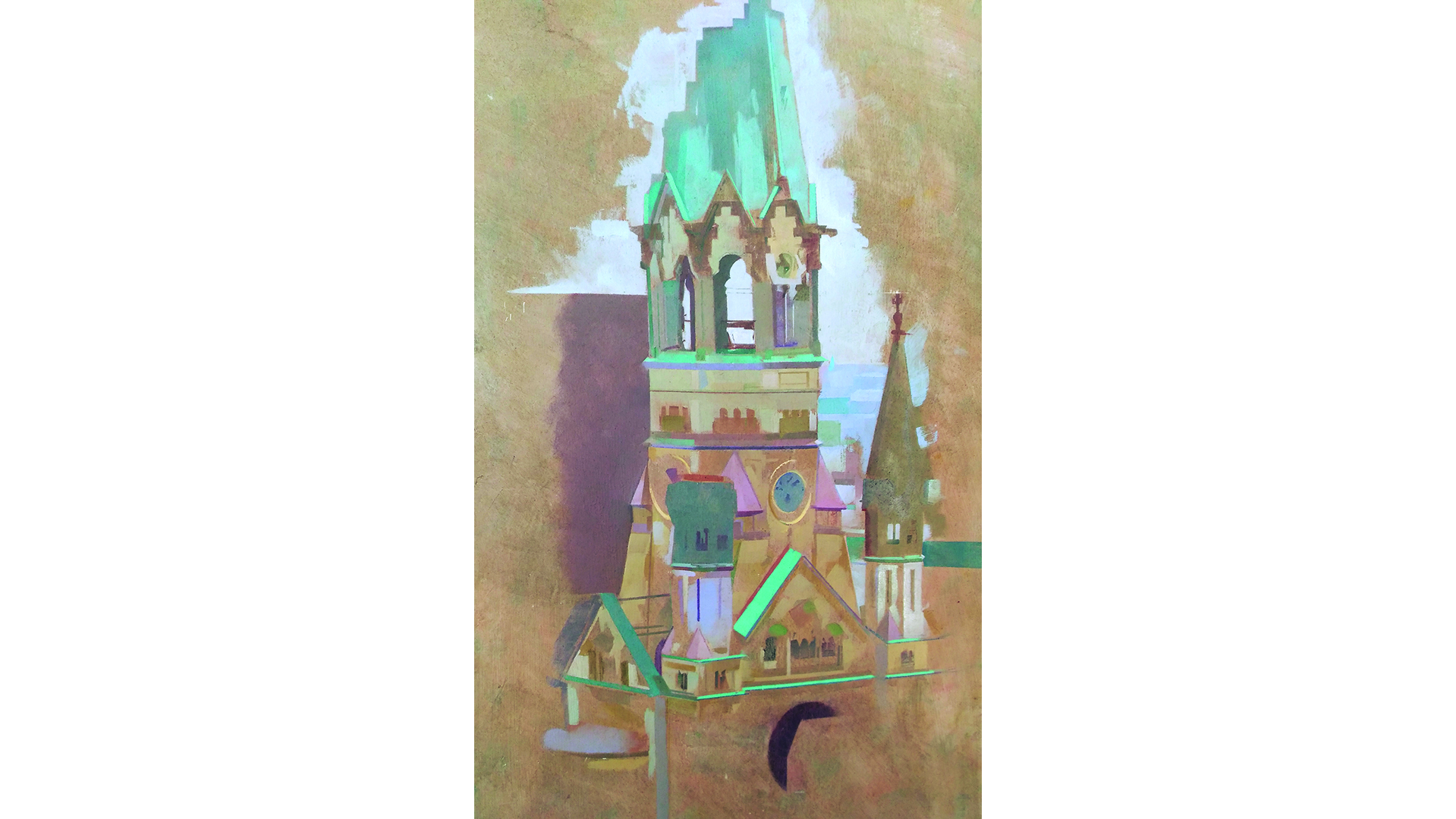11 tips for painting architecture

Ever since moving to Berlin, I’ve wanted to paint the Kaiser Wilhelm Memorial Church. After being bombed in WWII, it remained untouched as a testimony to the barbarism and sacrifice of war. It has always managed to catch my eye and soul.
• Oil colours: over 35 different pigments of various makes, but of the highest quality
• Brushes: mostly synthetic flats and flat round-headed sable
• EXACTO knife
• Odourless turpentine,
• Liquin
• Ruler
When painting from life, it is important to find a comfortable spot from which to paint. In the case of this church, that proved to be a difficult task because it is in a part of the city popular with tourists, and at the time of painting, it was the freezing Berlin winter.
I actually prefer to paint it in winter, because the weather and light conditions are more dramatic and gloomy. However, it does pose challenges, namely the changing weather and light conditions, and the shortness of the days.
Before starting, I visited the location and used a paper frame to establish the proportions and size of the composition. I also used this visit to decide on the colour and tone for the background. With the foundations sorted, all that remained was to capture the spirit of the building without painting every detail.
If you're a beginner, check out this guide on how to set up an oil paint palette before you get started. It can be a crowded market, so our shortlist of the best oil paints and best oil paint canvases might help you to kickstart your creative journey.
01. Gather your materials

Always stay prepared. Because the forms of this subject are constructed by light, I chose to use mostly flat brushes. They enable sharp edges, fine detail and distinct decisions. For atmospheric parts and creating a cloudy effect, I prefer flat, rounded brushes. I find that perhaps the most important thing is to choose your subject in advance. Every painting requires a different set of tools and a fresh approach.
From the bitter experience of forgetting to bring equipment, I make sure to have a wide range of tools comfortably at hand. I make a list of everything I have to carry with me to the spot where I paint, and I prepare everything the night before every session so I don’t waste time on it in the morning.
This particular work was painted with oil paints on a wooden panel, primed with smoothed, thick gesso layers, and washed with a neutral tint (chosen after visiting the location being painted, the chosen tint being the average colour of the subject, including its background). The size is 11.4x25.6in. Except for white, at least three different tones of every basic colour is used (cold, neutral and warm). This makes it possible to accurately paint the building’s colours and values. Clean turpentine is used to dilute the paints, which is changed often to keep it, and the colours, clean.
01. Begin applying colour

Don't be afraid to get stuck in. For me, starting a painting is always the hardest part, so I force myself to dive right into the work, first like a clerk, just ‘doing the movements’, but before long I find myself completely engaged. In many cases I find it useful to start with a part of the painting which is more general, and then gradually move on to the finer and more demanding areas. Basically, I believe that almost everything can become fascinating to paint if you are curious enough.
I always start by applying colour to rough-in shapes, without making a preliminary drawing. I work one area after the other, measuring the relations between them, one step at a time. For example, every mark made on the left will be meticulously checked by its relation to a detail on the right. Because I haven’t got a sketch, and I’m not painting every single detail, I look at the building as a series of shapes, rather than objects, to capture its form. For example here, I use the strong contrast between the broken roof of the church and the sky behind it and its abstract geometrical character as the basis for all future information.
02. Start to sharpen and expand

I add more detail to refine areas and move downwards to set up the foundations for the complex windows. I also add in a flat uniform plane for the section beneath the windows (although the details for this section will have to wait until this coat has dried).
03. Create large shapes

Still working downwards, I add in dividing lines to roughly mark out the shapes that need to be painted before any detail can be decided upon. I choose the average tone and colour of each one of these planes, ignoring whatever changes within. Many of these markings are temporary!
04. Use negative space and perspective

Every divider between large areas is measured several times in relation to the earlier shape. I start work on the smaller tower, using the negative space between the two towers. The rules of perspective helps decide the inclination of every slant.
05. Begin to work over areas

Now that a rough base has been established, I can expand areas in all directions, building every patch of paint in accordance to what was established earlier. I also start painting over the larger planes to give them more definition. Even though more detail is added, everything is still loose.
06. Be careful with complicated areas

The lower part of the church has quite a bit of space between areas, so it’s difficult to mark out dividing lines. In spots like this, it’s important to carefully measure against all the other areas. At this point I also give in to the temptation of adding some finer detail, but not too much!
07. Add the finer details

You will come to a stage when you need to add more intricate detail so you can move on to the remaining parts. Here, I’ve refined all of the roughed-out areas. Even though the marks are very simple and still quite loose, forms are becoming recognisable. I also add in rough shapes either side of the church.
08. Form the cityscape and fix mistakes

I form several patches on the lower part of the painting, just to establish some of the building’s limits. However, most of the work is on the cityscape behind and in- between both towers, as well as adding more detail to the smaller parts of the architecture. I encounter numerous delicate changes that need to be done and there are generally mistakes to be fixed!
09. Go back and forth

At this point I start to see the end. It is now a case of moving from detail to the whole, and back again. I have to be extra careful to not break the unity of the structure, and to maintain the balance of the composition when working on a detail. If at earlier stages I accentuated the differences between every painted patch, now is the time to start fine-tuning the details so as to not distract from the whole.
10. Decide what to include and what to ignore

I now feel confident enough to go all the way down. Note that I am leaving the panel exposed for most of the lower part. I find the colour and tone of it to be quite satisfying and do not feel I need to accentuate the obvious by blocking it in. I aim to achieve the feeling of distance between the viewer and the subject and I hint that the contrasts in these parts are smaller.
11. Finalise your piece

The differences between this step and the last are not very big, but they are significant. I want to suggest some of the pavement, and the lowest part of the church, differing only in colour and not in tone, so that the church seems rooted in real life. This is particularly important because of my choice of giving only general detail on the church’s lower parts. By leaving some of the details ‘unfinished’, I intend to imitate the imperfection of the subject and lead the viewer’s eyes only to what I find to be important.
Artistic creation has a reputation of being mostly inspirational, but a professional does not sit down, awaiting inspiration to come. It needs to be invited. As Picasso once wisely put it: “Inspiration exists, but it needs to find you working”. In any form of art, the soul manifests itself through material, and I find that you can maintain an interest and curiosity by accepting and falling in love with the process and with the painting materials – get to know them, their qualities and downsides. Any success is a result of an endless amount of mistakes and hesitations. When facing difficulties, remind yourself what a joy it is to paint!
This article originally appeared in Paint & Draw: Oils bookazine. Buy the bookazine from Magazines Direct.
Daily design news, reviews, how-tos and more, as picked by the editors.

Based in Berlin, Gemany, Amnon aims to express his way of seeing and interpreting the world through light, colour and atmosphere. Most of his subjects are the people and artifacts that surround him.
